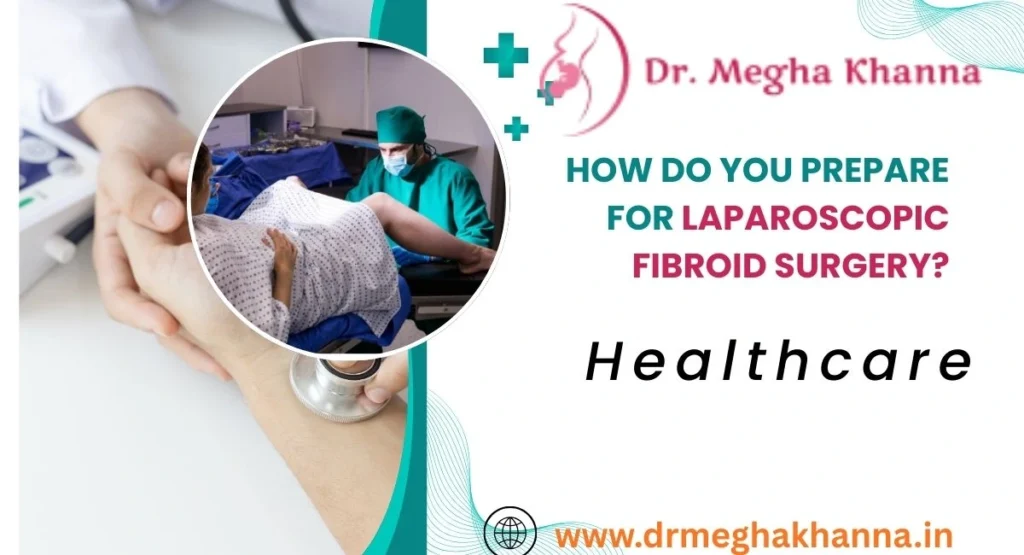-
Ganesh Talkies, Kolkata
Ganesh Talkies, Kolkata

MeghaKhanna
11.12.2025
Preparing for laparoscopic fibroid surgery is one of the most important steps to ensure a smooth procedure and quick recovery. Women often feel anxious before the operation, especially when they need expert guidance on diet, tests, medication, and hospital preparation. If you are consulting the best lady gynecologist in Kolkata or looking for a highly experienced Laparoscopic Vaginal Hysterectomy surgeon in Kolkata, understanding the exact preparation process will help you feel confident and informed. How do you take care of laparoscopic fibroid surgery?1: Understanding Laparoscopic Fibroid Surgery What Is Laparoscopic Fibroid Surgery?Who Performs This Surgery?Why Proper Preparation Matters?Benefits of Proper Pre-Surgery Preparation:3: Medical Evaluation Before SurgeryEssential Pre-Operative TestsBlood Tests:Imaging Tests:Other Evaluations: Medical Conditions to Stabilize Before SurgeryPre-Anesthesia Check (PAC)4: Diet & Lifestyle PreparationWhat to Eat 3–7 Days Before SurgeryDiet 24–48 Hours Before Surgery (Important)Fasting Rules (Day of Surgery) Lifestyle Preparation 5: Medication AdjustmentDiscuss All Medications with Your DoctorStop Before Surgery (If doctor advises):Continue Before Surgery (As advised):What About Birth Control Pills?6: Day-Before & Day-Of-Surgery PreparationThe Day Before SurgeryThe Morning of Surgery7: Hospital Preparation ChecklistWhat to Carry to the Hospital8: Emotional & Mental PreparationMental Readiness Tips9: What to Expect After Laparoscopic Fibroid SurgeryImmediate Post-Op ExpectationsRecovery TimelinePre-Surgery Do’s and Don’ts10: Why Choose Dr. Megha KhannaBest Lady Gynecologist in Kolkata – Here’s WhyTop Laparoscopic Vaginal Hysterectomy Surgeon in KolkataFAQsQ1: How do I prepare for laparoscopic fibroid surgery?Q2: Who is the best lady gynecologist in Kolkata for fibroid surgery?Q3: Can I eat the night before laparoscopic fibroid surgery?Q4: What should I avoid before laparoscopic surgery?Q5: Who is the best Laparoscopic Vaginal Hysterectomy surgeon in Kolkata? Under the care of Dr. Megha Khanna, known for her exceptional expertise in minimally invasive gynecologic surgeries, thousands of women have successfully undergone laparoscopic fibroid removal with safe results and rapid recovery. In this comprehensive guide, we explain every step of preparing for laparoscopic fibroid surgery—covering pre-operative tests, dietary instructions, medication rules, mental readiness, hospital planning, and postoperative expectations. Many women have faced a fibroid tumour and it needs surgery on an emergency basis so they need to do laparoscopic vaginal hysterectomy surgery which is fruitful for successful tumour removal. How do you take care of laparoscopic fibroid surgery? To prepare for laparoscopic fibroid surgery, complete all pre-operative tests, review medications with your gynecologist, follow a light and low-fiber diet for 24–48 hours, avoid solid food 8 hours before surgery, stay hydrated, arrange hospital essentials, stop smoking, control hypertension/diabetes, and follow bowel preparation...

MeghaKhanna
05.12.2025
Traveling during pregnancy can be safe when guided by the best lady gynecologist in Kolkata, especially under expert supervision like that of Dr. Megha Khanna. Many expectant mothers worry about long trips, flight safety, road travel discomfort, or infection risks. Getting proper medical advice, pregnancy checkups, and vaccinations allows you to travel comfortably and safely. This article offers evidence-based guidance, LSI-rich explanations, and travel tips every pregnant woman should follow. Why Consult the Best Lady Gynecologist in Kolkata Before Traveling?Q: Is traveling safe during pregnancy?Which Trimester Is the Safest for Travel?Travel Tips for Pregnant Women (Recommended by Dr. Megha Khanna)1. Get Medical Clearance Before You Travel2. Choose Comfortable Modes of Travel3. Stay Hydrated4. Wear Loose, Comfortable Clothing5. Take Frequent Breaks6. Carry Your Medical Records7. Eat Light and Healthy8. Vaccination Checks9. Avoid High-Risk Travel Areas10. Carry a Pregnancy Emergency KitSigns You Should Stop Traveling ImmediatelyExpert Advice from Dr. Megha Khanna – Best Lady Obstetrician in KolkataHow to Stay Comfortable During Long-Distance Travel?International Travel During PregnancyHow to Prevent Infections While Traveling?Mental Wellbeing While Traveling During Pregnancy?When Should Pregnant Women Avoid Traveling Altogether?FAQs1. Can I travel in early pregnancy?2. Which trimester is safe for traveling?3. Should I fly during pregnancy?4. What should I avoid while traveling pregnant?5. Who is the best lady gynecologist in Kolkata for pregnancy travel advice?6. Can road trips cause complications?7. Is international travel safe during pregnancy? Why Consult the Best Lady Gynecologist in Kolkata Before Traveling? Traveling during pregnancy involves health checks, fetal wellbeing assessment, and personalized travel recommendations.Dr. Megha Khanna, known as the best lady gynecologist in Kolkata, helps ensure: Safe trimester-wise travel High-risk pregnancy evaluation Motion sickness and nausea control Emergency advice for long-distance travel Vitamin supplementation planning Vaccination and infection risk assessment A pre-travel consultation protects both mother and baby. Q: Is traveling safe during pregnancy? A: Yes, traveling is generally safe during pregnancy if approved by your gynecologist, especially during the second trimester (13–28 weeks). Avoid long trips without breaks, stay hydrated, and follow medical advice to reduce complications. Which Trimester Is the Safest for Travel? TrimesterSafety LevelWhat to Expect1st Trimester (0–12 weeks)Moderate riskMorning sickness, fatigue, miscarriage risk2nd Trimester (13–28 weeks)SafestStable energy, lower risk, comfortable travel3rd Trimester (29–40 weeks)**Higher riskPreterm labor risk, discomfort, airline restrictions The safest window, according to most specialists, including the best lady gynecologist in Kolkata, is between 13–28 weeks. Travel Tips for Pregnant Women (Recommended by Dr. Megha Khanna) 1. Get...

Admin
17.11.2025
Hello Reader! Welcome to the blog page of Dr. Megha Khanna, one of the best lady gynecologist in Kolkata. Childbirth is one of the most beautiful experiences in a woman’s life — but it’s also one of the most painful. With advancements in modern obstetrics, women today have more choices for a comfortable birthing experience. One such option that has transformed labor pain management is epidural delivery. As the best lady gynecologist in Kolkata, I have seen how epidurals can help mothers stay calm, comfortable, and confident throughout childbirth. Let’s understand what epidural delivery is, how it works, and why many women now prefer it over traditional normal delivery without pain relief. What Is an Epidural Delivery?How Is Epidural Delivery Different from Normal Delivery?Benefits of Epidural Delivery1. Significant Pain Relief2. Better Control During Labor3. Reduces Fatigue and Anxiety4. Lowers Blood Pressure5. Aids Complicated Deliveries6. Smooth Transition to C-section if RequiredCommon Myths About Epidural DeliveryWho Can Opt for Epidural Delivery?What are the long-term maternal effects of an epidural vs a natural birth?Effect of epidural on chronic back pain and neurological symptoms?What neurological complications are reported after epidural anesthesiaWhat are the early warning signs of epidural hematoma after anesthesia?FAQ1. What is an epidural delivery?2. How is epidural delivery better than normal delivery in terms of pain relief?3. Does epidural help the mother stay relaxed during labour?4. Can epidural delivery make labour progress easier?5. Is epidural safe for both mother and baby?Why Choose Dr. Megha Khanna for Your Epidural Delivery?Final Thoughts What Is an Epidural Delivery? An epidural delivery involves administering anesthesia (a pain-relieving medication) into the lower spine — specifically into the epidural space. This medication blocks pain signals from traveling through the spinal nerves, significantly reducing labor pain while allowing the mother to remain awake and alert. The procedure is performed by an anesthesiologist under the supervision of an experienced obstetrician. At my clinic, as the best lady gynecologist in Kolkata, I ensure the entire process is conducted safely with constant monitoring of both mother and baby. How Is Epidural Delivery Different from Normal Delivery? In a normal delivery without any pain relief, the mother experiences full intensity of contractions and pain during labor. While some women choose to endure this natural process, others may find it overwhelming or exhausting. In contrast, an epidural delivery provides targeted pain relief during labor, helping mothers stay relaxed, conserve energy, and experience childbirth more...

Admins
31.10.2025
Learn why early pregnancy scans are crucial for both the mother's and baby’s health. Understand their purpose, timing, and benefits from the insights of a reputed gynecologist, ensuring a safe and confident start to motherhood. The news of pregnancy often brings a beautiful mix of excitement, curiosity, and concern. For many expecting mothers, the journey begins with questions—Is my baby healthy? Is the pregnancy progressing normally? What should I do next? Understanding the Purpose of Early Pregnancy ScansThe Science Behind Early Pregnancy ScansWhy Early Pregnancy Scans Are a Must1. Confirmation of Pregnancy and Viability2. Detecting Ectopic or Abnormal Pregnancies3. Accurate Dating of Pregnancy4. Monitoring Multiple Pregnancies5. Emotional Reassurance for Expecting Parents6. Planning Health and Lifestyle AdjustmentsThe Ideal Time for Early Pregnancy ScansPreparing for an Early Pregnancy ScanAddressing Common ConcernsThe Psychological Benefits of Early Pregnancy ScansThe Role of Expert GuidanceFAQsA Gentle Start to Motherhood That’s where early pregnancy scans play a vital role. These initial ultrasounds provide a detailed look into the early stages of pregnancy, confirming both the baby’s presence and well-being. Far beyond a medical procedure, they are moments of reassurance, helping expectant parents take their first confident step toward a healthy journey ahead. Understanding the Purpose of Early Pregnancy Scans An early scan—usually conducted between 6 to 10 weeks of pregnancy—is designed to gather essential information about the developing embryo and ensure that everything is progressing as expected. The main purposes include: Confirming pregnancy and checking for the presence of a gestational sac. Determining whether the pregnancy is single or multiple (twins or more). Identifying the location of the embryo to rule out ectopic pregnancy. Measuring the baby’s heartbeat and early growth. Estimating the gestational age and due date more accurately. In simple terms, these scans are like the foundation of your pregnancy care plan—ensuring that your journey begins on the right track. The Science Behind Early Pregnancy Scans During early pregnancy, the body undergoes dramatic changes within just a few weeks. Hormones surge, tissues expand, and new life starts forming rapidly. However, not all these changes can be detected through symptoms alone. That’s why sonographic imaging becomes so important—it offers a visual confirmation of what’s happening inside. Transvaginal Scans: Often used in the earliest weeks, this scan provides a clearer view of the uterus and developing embryo. Abdominal Scans: Commonly used after 8 weeks when the uterus grows above the pelvic bone. Both types are safe, non-invasive,...